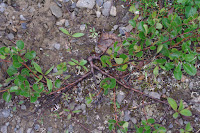
I just returned from a week-long trip to Fairbanks in central Alaska. I quickly noted the abundant wild irises (
Iris setosa interior) in bloom around the city. The species is endemic through much of Alaska, with a few regional subspecies/varieties. It goes by a few different common names. "Beachhead Iris" seems to be the most common, though I prefer "Alaska Iris" for the plants I encountered because it more clearly refers to the specific Alaskan sub-species.
While I was there, the local paper (
Fairbanks Daily News-Miner) published an article about Jack Finch, a metalworking instructor at the local university, who has a long-running hobby of breeding
I. setosa.
Though we tend to refer to all the colorful floral structures of a typical garden iris as "petals", the structures are botanically divided into the true petals (upright standards) and petaloid sepals (descending falls). In
I. setosa, the botanical petals are reduced so severely that the flower appears to have only three "petals". Jack Finch occasionally sells plants in Fairbanks, which probably helps explain the diversity of colored forms I found in gardens during my week.
In addition to numerous shades, Jack Finch also isolated a recessive mutation which converts the tiny petals of the wild flower into full-sized sepals (thus producing an attractive and larger flower). I never did find an example of this flower, but the newspaper published a photo which nicely illustrates the variation.
During my trip I was able to collect seeds from several plants with different colored flowers. As the plants were in full bloom, the only seeds to be found were those left-over from the previous season or two. Hopefully they remain viable so that when I plant them this fall (for cold-stratification) they can start growing in spring.
The
Iris genus is subdivided into several sub-genera, which are then in turn subdivided into several series of species. For the wild
Iris setosa I was so admiring, the full nomenclature is something like: [Genus =
Iris] [Subgenus =
Limniris] [Series =
Tripetalae] [Species =
setosa] [Subspecies =
interior].
Species definitions in plants are often less strict than they seem to be for animals. Some research from a few years ago sought to identify how
I. setosa was related to other North American wild irises. They found
I. setosa was most likely one of the parents (with
I. virginica) of
I. versicolor.
I. setosa and
I. virginica are both diploid with 38 (19/19) and 70 (35/35) chromosomes, respectively. The hybrid between the two species is infertile due to mis-paired chromosome sets (19/35). But like in other cases (
http://the-biologist-is-in.blogspot.com/2015/01/hybrid-sterility-and-speciation.html), that infertility can be resolved by a whole genome duplication like that which appears to have happened in the ancestors of modern
I. versicolor.
References:









